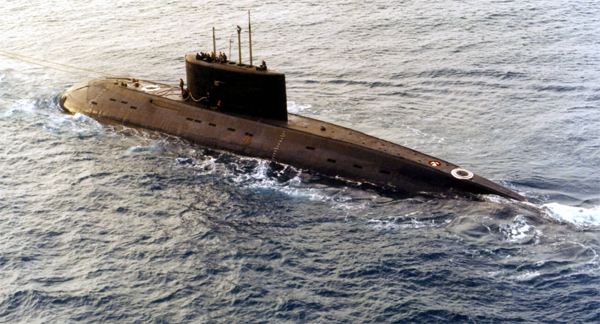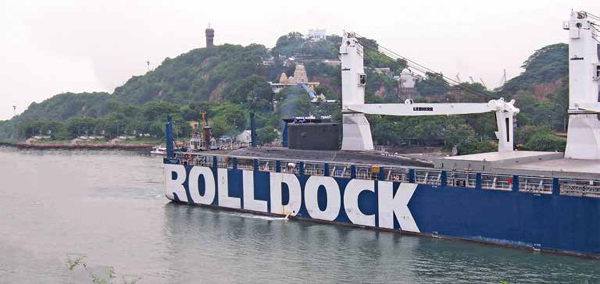|
The indigenous nuclear propelled nuclear armed
(SSBN) Arihant is progressing well and only on
August 10, its
nuclear reactor was activated, a major step towards
its journey forward for sea trials and deployment.
The 82.5 MW nuclear reactor for submarine was
designed at Kalpakkam by PRP Centre - PRP originally
stood for Plutonium Reprocessing Project under
the Bhabha Atomic Research Centre (BARC).
The Navy’s safety record was broken on August
14 when two large white and orange explosions
were seen, heard and photographed from the nearby
Taj Mahal Hotel in Mumbai just after midnight,
when India was getting ready to celebrate its
67th Independence Day.
The explosions led to the sinking of the 2,300
ton Kilo class conventional submarine, INS Sindhurakshak
(protector of the seas), berthed in Navy’s Dockyard
in the heart of Mumbai.
Sindhurakshak in fact was transported to Severodnsik
in Russia on board a heavy lift ship from Vishakpatnam
(See photo) in June 2010 only, for refit and modernisation.
It had returned a few months ago fully operational,
torpedo and Klub missile capable. Hence the accident
shocked the nation and surprised the Navy’s submarine
community which is a close knit professional arm.
The submarine arm is a ‘silent service’ and very
little is written about the service’s operational
roles.
It may be recalled that Captain Alexander Ivanovich
Terenov, the Russian safety captain of the Project
670 K-43 nuclear submarine INS Chakra from 1986
to 1991, who initially trained the Indian crews
at Vladivostok, and then served alongside the
three successive Indian captains for four years,
has praised the Indian submariners for their professionalism
in his book, “Under Three Flags, The Saga of the
Submarine Cruiser K43/Chakra.”

The nuclear propelled Charlie was taken on a
three year lease from 1988 from the Soviet Union.
The deal was facilitated by Admiral of the Fleet
Sergie Gorshkov, who was impressed by the Indian
Navy’s Styx missile attacks off Karachi in the
1971 war and employment of Soviet supplied warships
and submarines.
He reposed confidence that the Indian Navy could
operate nuclear submarines effectively. The then
Prime Minister, Mrs Indira Gandhi, had initiated
discussions with Soviet leaders for leasing a
nuclear submarine.
The Indian crew under Captain Ravi Ganesh took
over the K-43 and named her INS Chakra. Around
then, US President Ronald Reagan asked Moscow
not to transfer the boat. The crew had completed
training by December 1987, but was kept waiting
in Vladivostok and not allowed to go on board
for some time.
The book indicates that it was Prime Minister
Rajiv Gandhi who then managed to swing the transfer
by approaching President Mikhail Gorbachev. The
submarine was hurriedly commissioned and christened
INS Chakra by T.N. Kaul, India’s Ambassador to
Russia, who hosted a lunch and sailed out of Vladivostok
on January 5, 1988 when the temperature was minus
25 degrees C.
The Chakra was ordered by NHQ to dive and proceed
till the Malacca Straits underwater to avoid detection.
Jane’s Defence weekly photographed her off Singapore
from where a naval warship escorted her to home
waters. On February 3, 1988, Rajiv Gandhi personally
embarked the INS Chakra off Vishakapatnam to welcome
her into the Indian fleet.
The submarine dived, and the PM and his entourage
had lunch with the Officers and the Coxswain,
an important key senior sailor whilst under nuclear
power underwater. The Indian crew handled the
reactor well after the Russians put the officers
and sailors through the paces of nuclear operation.
INS Chakra was operated for 72,000 nautical miles
(133,000km), and her reactor was active for 430
days.
Five missile and 42 torpedo firings were executed
under the Indian command with Russian supervision
on board for safety, which speaks volumes of operational
capabilities over four years.
An accident and fire on board the Chakra in
1989 saw her lose electric power and descend from
40 feet to 200 feet. The crew expeditiously ordered
‘emergency blowing of the tanks’ to surface the
boat. The fire was contained and put off by joint
heroic action of the Indian crew and the few Russians
on board including Terenov. There was no radioactive
leakage and the submarine returned to Vishakapatnam
on her own, possibly under diesel power, or with
assistance of tugs as the reactor must have been
scrammed (emergency shut). A Russian support team
and the naval dockyard took three months to put
her back to the sea.
Submarine accidents nonetheless have happened
worldwide including in the US, UK and, the Soviet
Navies; each equipped with major submarine arms.
There are lessons to draw from them.
It would be imperative for the Indian Navy to
examine the cause/s of all submarine accidents–
technical or human failures– and do the needful
as preventive measures.
INS SINDHURAKSHAK
Many dangers lurk when operating submarines.
Therefore the question whether the explosions
in Sindhurakshak were caused by a systemic, a
human or material failure or due to sabotage is
haunting those who have served in the Indian Navy,
and will be speculated, as all the 18 on board
including the First Lieutenant and two Lt Commanders
and five Under Water Control (UCs) sailors who
deal with anti-submarine warfare perished.

The evidence of the three sailors on the casing
who jumped to safety will be vital, as they would
have been aware of what was going on ‘down below’.
The revelations of the night orders that the Commanding
Officer had left for the duty crew of Sindhurakshak
will be crucial as the submarine was to sail that
morning for an operational patrol possibly with
armed torpedoes and missiles which normally entails
the critical drill of inserting primers and detonators
into the weapons.
The submarine has six torpedo tubes in the bows
which can be loaded with torpedoes or missiles,
and can carry 12 additional torpedoes/missiles
in racks. As Standard Operating Procedure (SOP)
in most navies, operational submarines and ships
invariably proceed on patrol with torpedoes and
missiles, and some are armed in the tubes which
have watertight front covers and are considered
very safe. The saying goes the ‘weapons in the
tubes are safer than the weapons in the racks’.
The weapons in the racks are open to view and
touch.
Defence Minister AK Antony and CNS Admiral DK
Joshi held a press briefing in Mumbai and mentioned
the bow part of the submarine was mangled and
had suffered large damage. That is where the torpedoes
and missiles are housed in the 21 inch torpedo
tubes. A Naval Board of Inquiry (BOI) is looking
in to the causes of the sinking of Sindhurakshak,
and the contract to salvage the submarine is being
awarded for the hull to be lifted up. The damaged
weapons and hull should offer pointers but the
direct evidence will be scanty as all those working
in the boat perished.
But notwithstanding this accident, the record
of the Indian Naval Submariners deserves lauding.
The Indian Navy is ready to operate new generation
submarines, both nuclear and conventional over
the coming years.
Pix Credit: DPR
|